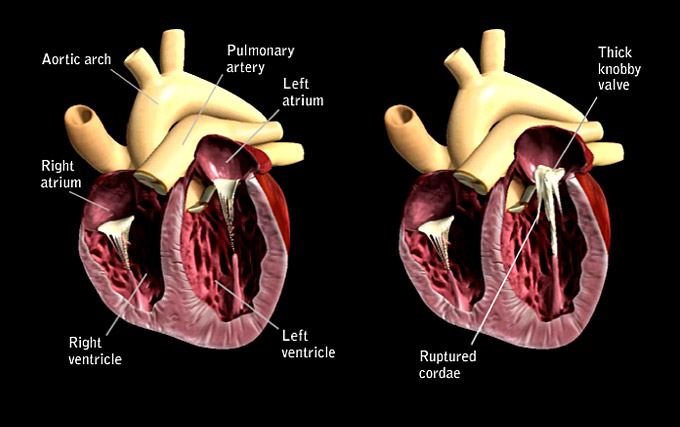Overview
Valvular heart disease (VHD) is a condition caused by the breakdown and thickening of the valves of the heart. In order to understand the impact of this disease, we need to look at the anatomy of your cat’s heart.
Your cat’s heart, like yours, is a four-chambered pump made of muscle. The valves of the heart work to keep blood flowing in the correct direction. Normally, blood moves first into the atrium, the pump primer. The atrium then contracts, pushing blood into the ventricle, which serves as the pump. Normal pump function requires that blood move always in this direction. However, with VHD, degenerative changes in the valve between the atrium and the ventricle cause it to become thick and distorted. As a result, the edges don’t make a tight seal when the valve shuts and small amounts of blood leak from the ventricle into the atrium with each heartbeat. To compensate for this leaky valve, the heart has to pump more blood with each beat, causing the heart to enlarge over time. This extra workload causes the heart to become ineffective and unable to keep up with the body’s demand for blood flow. This inability to supply the body with the blood it needs is known as congestive heart failure.

Symptoms
Unfortunately, in the early stages of heart disease, your cat’s body may make adjustments that allow him to cope with the disease. During this stage, your cat may show no visible signs of being sick.
As time goes on and the disease progresses, you may notice any of the following symptoms:
- Coughing
- Breathing difficulty
- Exercise intolerance
- Fainting
- Pale gums
- Loss of appetite
Diagnosis & Treatment
Your veterinarian will perform a very thorough physical examination, which includes listening to your pet’s heart, and may also recommend the following to help diagnose your cat’s condition:
- A radiograph, commonly known as an X-ray
- A blood test for a cardiac biomarker called NTproBNP
- A chemistry profile and complete blood count (CBC ) to assess your pet's overall health
- A blood pressure test
- An ECG (electrocardiograph) to record the electrical action in your pet’s heart
- An echocardiogram
If your cat is diagnosed with valvular heart disease, your veterinarian may prescribe the following treatment:
- Nutritional therapy, such as a low-sodium diet
- Diuretics to remove excess fluids from the body
- Regular but controlled daily exercise
- For advanced cases, drug therapy
Prevention
Unfortunately, VHD is a progressive disease that can’t be prevented. However, routine veterinary visits with your furry friend can help identify heart conditions such as VHD in their earliest stages.
To learn more about feline heart disease, visit www.yourcatsheart.com.
If you have any questions or concerns, you should always visit or call your veterinarian – they are your best resource to ensure the health and well-being of your pets.
